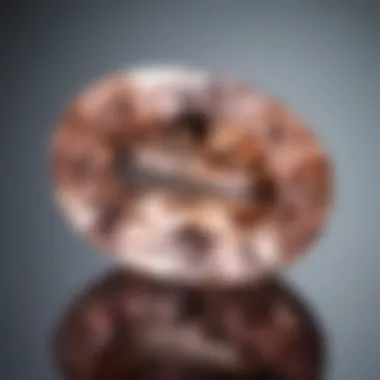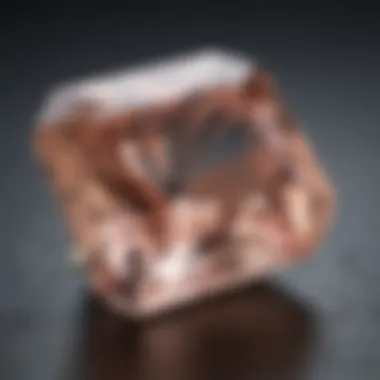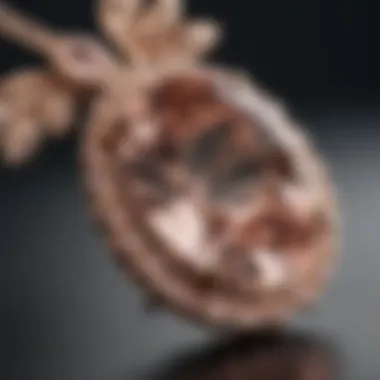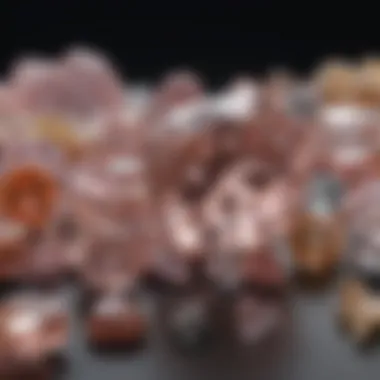Morganite Hardness and Characteristics Explored


Intro
Morganite, a captivating gemstone belonging to the beryl family, has been gaining attention among gemstone enthusiasts and jewelry lovers alike. Its delicate pink to peach hues evoke a sense of warmth and tranquility, making it a favored choice in modern jewelry design. But there’s more to morganite than just its breathtaking aesthetics. Understanding its hardness and practical properties is essential for anyone looking to appreciate or utilize this gemstone.
In this article, we will explore the intricate details of morganite. By examining its hardness on the Mohs scale, we can determine its wearability. Additionally, the analysis will cover its physical characteristics, origins, and the implications for its maintenance and care. Through this exploration, we aim to equip enthusiasts and professionals with valuable insights into morganite’s unique attributes and applications.
Prelims to Morganite
Morganite, a variety of beryl, has carved out quite a niche for itself in the world of gemstones. This introduction serves as a foundation for understanding its rarity, beauty, and most significantly, its hardness – a feature that deserves particular attention when discussing practical applications in jewelry. Knowing how this gemstone fits into the hardness classification helps enthusiasts, collectors, and designers appreciate its durability while understanding its care needs.
One of the key reasons to delve into morganite is its allure. With delicate hues ranging from soft pink to peach, it offers a romantic alternative to traditional gems like diamonds. Yet, its beauty isn't merely skin deep; understanding its hardness sparks conversations about the gemstone's place in everyday use. How well does it withstand the wear and tear of daily life? Is it suitable for rings worn on a regular basis? These questions are essential for making informed decisions that are both aesthetic and practical.
But it’s not just about beauty and utility. The significance of studying morganite extends to appreciating its origins and the science behind its formation. An informed buyer or a jewelry designer can better gauge how to integrate morganite into their creative endeavors when they understand its characteristics deeply.
"Morganite is as tough as it is beautiful; knowing its properties allows one to truly appreciate what this gem has to offer."
In this article, we will traverse through the intricate layers of morganite, honing in on its definition and historical context before delving deeper into its physical properties and practical applications. We aim to equip our readers with actionable knowledge to enhance their understanding of morganite and its nuances in the realm of gemstones.
The Hardness Scale Explained
The hardness scale serves as a fundamental tool in understanding gemstone durability and functionality, particularly when it comes to morganite. This section explains why grasping the hardness scale is a must for anyone dealing with gemstones, whether for collection, aesthetic display, or jewelry design.
When examining morganite, knowing its hardness offers insights into its practicality. A gem's hardness indicates its resistance to scratches and wear, factors that are crucial for everyday jewelry. When you consider precious materials and environments they undergo, the hardness scale becomes more than just numbers; it’s essentially a benchmark of resilience.
Understanding Mohs Hardness Scale
Here's where we delve into the Mohs Hardness Scale, a scale devised by Friedrich Mohs in the early 19th century. This scale categorizes minerals from 1 to 10 based on their ability to scratch one another. At the lower end, talc (rated at 1) can be easily scratched by fingernails. On the flip side, diamonds, holding a rating of 10, are tough enough to scratch all others.
Morganite, a member of the beryl family, holds a score of 7.5 to 8 on this scale. This rating places it in a commendable position among gemstones, indicating considerable sturdiness. It’s subjects to scratching, but not as easily as softer stones like amethyst (rated at 7) or topaz (rated at 8). Stepping up in hardness equates to improved wearability and longevity in jewelry.
The Mohs scale is not just a curious number system; it's a vital reference point for appraisers and jewelers alike. When making decisions about setting these gemstones, understanding where morganite falls within this hierarchy can influence choices in personal wear and commercial production alike.
How Hardness is Measured
Understanding how hardness is measured goes hand in hand with the discussions we've had about the Mohs scale. Gemologists typically gauge hardness through direct contact scratch tests. In practice, a harder material will scratch a softer one, making it possible to categorize minerals based on their resistance.
While Mohs scale offers qualitative insight, modern tools such as the Vickers hardness test provide quantitative data. This is conducted by pressing a diamond-tipped tool into a material, measuring the indentation to determine hardness in a more precise manner. However, it’s important to note that the results might be more relevant in industrial applications than for gemstones directly.
In practical terms, as a gem enthusiast or jewelry designer, knowing how hardness is assessed gives you a solid foundation when selecting stones for various applications. The right balance of aesthetic appeal and physical durability ensures that jewelry crafted from morganite will withstand both time and use, making it a beloved choice among many.
Morganite's Position on the Hardness Scale
Analyzing morganite's position on the hardness scale offers vital insights into its practicality and appeal, particularly for jewelry makers and gemstone enthusiasts. This section illustrates why understanding the hardness of morganite is key to its durability, maintainability, and overall desirability as a gemstone. Unlike soft stones that scratch easily, morganite's hardness contributes to its ability to withstand daily wear, making it a popular choice in fine jewelry. The significance of its hardness transcends mere numbers; it informs users about the best uses and care techniques for this striking gem.


Morganite's Hardness Rating
Morganite, as part of the beryl family, holds a hardness rating of 7.5 to 8 on the Mohs scale. This places it in the upper echelon of gemstones, providing a balance between beauty and durability. Its resilience stems from its crystalline structure, allowing it to resist scratching while retaining a luminosity that can captivate the eye. Such attributes are what many jewelry designers seek for pieces that are both stunning and practical.
Regular maintenance, however, remains essential to keep morganite looking its best. While it stands up well against wear, exposure to certain conditions can diminish its luster.
Comparative Hardness of Morganite
Comparison with Beryl Family
When one compares morganite to other members of the beryl family, such as emerald and aquamarine, it stands out in an array of ways. Emerald, for instance, registers similarly on the hardness scale; however, it is more prone to inclusions due to its formation process. Meanwhile, aquamarine tends to have a clear and crisp appearance, though it might lack some of the warmth that morganite provides.
This makes morganite particularly appealing for those who desire a softer hue coupled with solid durability. If you're keen on wearing a gemstone daily, morganite is a commendable choice. It offers beauty and resilience, making it a favorite among jewelry consumers who want a unique piece without compromising on the wearability aspect.
Comparison with Other Gemstones
When we look outside the beryl family to some well-known gemstones like sapphire and amethyst, morganite still holds its ground firmly. Sapphire is revered for its hardness, ringing in at 9 on the Mohs scale. However, it's often more expensive and may not offer the soft color tones that morganite does. Amethyst, on the other hand, has a lower hardness rating of around 7, making it somewhat more susceptible to scratches and abrasions.
Hence, morganite finds a unique niche by combining beauty and durability to beat many of its competitors in terms of aesthetic flexibility and practical use in everyday jewelry. For enthusiasts seeking distinctive color without the worry of frequent damage, morganite strikes the right chord. It boasts a well-rounded profile that allows it to not only dazzle but also endure.
Physical Properties of Morganite
The physical properties of morganite are crucial for anyone interested in this beautiful gemstone. Understanding these features can significantly enhance appreciation for what makes morganite unique and desirable. These properties affect not just its aesthetic appeal but also its practicality in various uses such as jewelry. A deep dive into its color characteristics and crystal structure gives insight into how those properties define the overall essence of morganite.
Color Characteristics
Natural Color Variations
Morganite boasts a captivating range of natural color variations, which can be seen as pink, peach, or even coral shades. This feature is among its key characteristics, making morganite a popular choice for many collectors and jewelry enthusiasts. Unlike some gemstones that may only exhibit one color, morganite's hues can vary widely depending on the specific composition and conditions of its formation.
This variation contributes significantly to its allure. Each gemstone's uniqueness is often what draws buyers—no two stones can look the same, and this individuality speaks volumes. While the light pink tone is often the dominant one, deeper, more saturated colors are sometimes found, adding to its charm. However, one should note that a significant disadvantage might be in identifying quality because color can be subjective, and personal preference plays a big role in valuation.
Influence of Treatment on Color
Talking about color wouldn’t be complete without mentioning treatments, which can dramatically influence a gemstone's appearance. Morganite often undergoes a variety of treatments, like irradiation or heat, intended to enhance its color and, sometimes, clarity. These treatments can lead to vibrant hues that might otherwise be uncommon in naturally occurring stones.
The significant characteristic here is that while treatments can improve the stone's visual appeal, they can also complicate matters for collectors and jewelers during evaluation. Authenticity is essential, and knowing whether a stone has been treated becomes crucial for its value. Moreover, not all treatments are permanent; some may fade over time, making it essential to consider the long-term implications of treatment when purchasing morganite.
Crystal Structure and Formation
Types of Crystal Forms
The crystal forms of morganite also play a vital role in understanding its physical properties. This gemstone primarily adopts a hexagonal crystal system, which affects its overall appearance and structural integrity. The beauty of morganite isn’t just skin-deep; its crystal lattice contributes to its striking color and clarity.
The hexagonal form is often seen as beneficial for gem quality because it allows for the formation of large, well-developed crystals which can be cut into gorgeous gemstones. Each crystal structure bears a unique set of optical properties. However, potential buyers should be cautious: irregularities in the crystal can indicate a lower quality or less stable stone.


Geological Formation Process
Lastly, it’s essential to discuss the geological formation process of morganite. This gemstone originates from pegmatitic environments, where it forms in slow-cooling magma. This slow crystallization allows for the growth of larger crystals, which are highly valued in the gemstone market.
This geological aspect is interesting because it reveals much about morganite's rarity and availability. Since morganite typically forms in specific conditions, quality specimens are often hard to come by. This rarity can bolster its desirability, but geological formation can also mean certain types may only show up in specific regions, which can influence everything from trading to personal collections.
In summary, understanding the physical properties of morganite—from its stunning color variations to its unique crystal formations—is essential for anyone serious about gemstones. These characteristics not only affect visual appeal but also inform practical applications in jewelry use. Knowing what makes these properties special could very well shape the approach to buying, wearing, and caring for this stunning stone.
Remember that while beauty might catch the eye, the characteristics define the value.
Significance of Hardness for Jewelry Use
When it comes to the world of gemstones, the hardness of a stone like morganite plays a pivotal role in determining not just its use in jewelry, but also its longevity and overall appeal. Understanding the significance of hardness can make a world of difference for jewelers, collectors, and consumers. It informs decisions about durability, maintenance, and stylish settings, ensuring that morganite can be worn with confidence for years to come.
Given that morganite has a hardness rating of 7.5 to 8 on the Mohs scale, it strikes a balance between elegance and resilience. This means it can withstand the daily rigors of life without losing its luster or developing scratches. Unlike softer stones, which can barely hold up against a busy lifestyle, morganite can handle everyday wear. Understanding this characteristic makes it an enticing option.
Wearability and Durability
The wearability of morganite is a key consideration. Its respectable hardness makes it suitable for rings, earrings, and pendants alike. Unlike diamonds or rubies, which are often thought of as the toughest stones, morganite offers an alternative that stands strong while providing gorgeous aesthetics. The captivating hues of morganite, from peach to pink, add appeal, but it’s the hardness that ensures wearers can enjoy these colors in their jewelry without constant worry.
However, despite its relative durability, one must not overlook that care is still needed to maintain its beauty. Avoiding hard blows and harsh chemicals is essential to keep morganite shining brightly. With a little mindfulness, this gem can shine in any jewelry collection.
Setting Morganite in Jewelry
When it comes to how morganite is set in jewelry, several factors come into play. The right setting not only highlights the stone's natural beauty but also protects its integrity. This leads to a few strong contenders in terms of setting styles.
Best Types of Settings
The best types of settings for morganite often include four-prong, bezel, and halo styles. The four-prong setting is a popular choice as it holds the stone securely while allowing light to flow through, enhancing its sparkle. The best part? This setting doesn't overshadow the morganite but instead accentuates its color.
Bezel settings are another excellent option. They encircle the gemstone, offering unparalleled protection against damage. This can be especially beneficial for stones that are often exposed to dings during daily wear. Plus, the sleek, modern look of a bezel can add a sophisticated touch to any piece.
Halo settings, where smaller stones surround the larger morganite, not only increase visual interest but also create an illusion of size. This can be a crowd-pleaser, particularly for those wanting to make a statement with their jewelry. The duality of beauty and protection makes these settings a powerful choice.
Considerations for Daily Wear
When thinking about daily wear, certain considerations become crucial. It's not just about choosing a beautiful setting; it’s about functionality too. Comfort and practicality can't be overstated. For everyday pieces, lighter settings may offer comfort, while sturdier options can provide additional security.
Moreover, morganite jewelry should ideally be designed with low-profile settings. This minimizes the risk of snagging on everyday items, be it a handbag or clothing. Additionally, choosing materials that are hypoallergenic and durable ensures that pieces remain comfortable throughout daily activities.
Interestingly, the care and maintenance of morganite jewelry leads to another consideration. Wearing morganite in an environment with extreme temperature changes or exposure to harsh chemicals can affect its beauty and strength. Taking care in these aspects enhances the longevity of the piece, ensuring it remains a cherished item for years.
"A thoughtful choice in both setting and daily wear can turn a beautiful piece of morganite jewelry into an heirloom for ages."
By carefully selecting settings and keeping wearability in mind, morganite enthusiasts can confidently showcase their jewels, knowing they balance high style with everyday practicality.


Care and Maintenance of Morganite
Maintaining morganite is essential not just for preserving its beauty but also for ensuring that its durability remains intact. This section delves into the importance of both cleaning techniques and preventative measures against damage to maximize its longevity and appeal.
Cleaning Techniques
Cleaning morganite is straightforward yet should be done with care. Unlike some gemstones that may tolerate rough handling, morganite's delicate structure necessitates a gentle touch. Here are some suggested cleaning methods:
- Warm Soapy Water: Using a mild soap in warm water is one of the safest methods. Soak the morganite jewelry for a few minutes and gently scrub it with a soft toothbrush. This helps remove any grime without scratching the surface.
- Ultrasonic Cleaners: While many gemstones can withstand ultrasonic cleansing, it’s better to approach this method with caution for morganite. Always consult a jeweler before using an ultrasonic cleaner.
- Avoid Harsh Chemicals: Steer clear of bleach or ammonia-based cleaners as these can damage the stone’s surface or alter its color.
Preventative Measures Against Damage
Implementing preventative measures can greatly prolong the life of your morganite. Here are some ways to keep your gem in pristine condition:
Storage Recommendations
When not being worn, how you store your morganite matters significantly. Here are some tips for good storage:
- Soft, Padded Storage: Store morganite pieces in a soft-lined jewelry box or pouch to prevent scratches from harder materials.
- Keep Away from Sunlight: Prolonged exposure to sunlight can lead to fading or altering of colors in some gemstones, including morganite. A dark or shaded area is a wise choice for storage.
- Separate from Other Jewelry: To avoid scratches, it’s beneficial to keep morganite away from other jewelry. Using individual cloth pouches or compartmentalized jewelry organizers is a popular solution.
Any gemstone, morganite included, deserves a safe space away from the hustle and bustle of everyday life. Treating your gem with respect will pay off in the long run, preserving its original luster and charm.
Impact of Environmental Factors
Environmental factors play a significant role in the preservation of morganite. Understanding them can help you make informed choices:
- Humidity and Temperature Control: Morganite is sensitive to extreme changes in temperature and humidity. Storing it in a stable environment helps avoid alterations in its physical and visual properties.
- Avoiding Chemical Exposures: Regular exposure to cosmetics or household cleaners can damage morganite. It is wise to put on jewelry after applying makeup or using cleaning products.
- Understand Your Lifestyle: If you engage in activities that involve chemicals or physical stress, it may be best to remove your morganite jewelry during those times to avoid unwanted damage.
By paying attention to cleaning techniques and implementing robust preventative measures, owners of morganite can enjoy its beauty without the worry of early wear and tear. Taking these precautions ensures that each piece remains not only an aesthetic delight but also a cherished keepsake for years to come.
Finale
The conclusion of this article draws the threads of understanding together, highlighting the intricate relationship between the hardness of morganite and its role in both aesthetic appeal and practical application. By closely examining morganite's position on the Mohs hardness scale, enthusiasts gain insight into its durability and its suitability for various forms of jewelry. This gemstone’s remarkable features go beyond mere beauty, intricately linking physical properties to how one should care for and set it in everyday wear. The significance of durability in gemstones like morganite cannot be overstated. Knowledge of hardness informs collectors and designers about the longevity of their pieces and how they fit into various lifestyles.
Moreover, understanding the nuances of morganite’s characteristics emphasizes the importance of gem properties beyond their visual allure. A gemstone's appearance may attract buyers, but its maintenance and practicality in real-world settings ultimately determine its true value. As jewelers and consumers navigate choices in the market, they should remain aware that the beauty of morganite is matched by its need for conscious care.
"An informed choice leads to lasting appreciation, especially with gemstones as splendid as morganite."
Through careful consideration of the insights shared regarding wearability, durability, and maintenance, readers are equipped to better appreciate or utilize morganite in their endeavors. As experts and novices interact with this gemstone, a deeper understanding of its properties encourages responsible ownership and thoughtful utilization in creative designs, enhancing not just individual pieces of jewelry but the overall experience of enjoying natural beauty.
Summary of Key Insights
- Morganite, a member of the beryl family, shines with its soft pink to peach hues, making it highly desirable in jewelry.
- Its hardness rating of 7.5-8 on the Mohs scale places it in a comfortable position for daily wear, standing up to the rigors of life much better than many other gemstones, but still requires care to maintain its brilliance.
- Cleaning morganite involves simple methods, ensuring that the gemstone retains its luster over time.
- Proper storage practices are crucial to prevent scratches and damage from external environments, a necessary aspect for safeguarding one's investment.
- The relationship between hardness and other physical properties like color and clarity highlights the gemstone's overall appeal, packaging beauty and practicality in one exquisite stone.
Future Considerations in Morganite Study
Looking ahead, the study of morganite may expand in several noteworthy directions:
- Technological Advances in Gemology: New technology could refine techniques for clearer assessments of stone properties, including advanced imaging and hardness testing, providing even better insights into morganite's characteristics.
- Sustainable Practices: With increasing concern over environmental impacts, there is a rising trend towards ethical mining and processing of gemstones. The exploration of sustainable practices within the morganite market can propel both responsible sourcing and consumer awareness.
- Use in Modern Designs: Trends in jewelry design continually evolve, and morganite may find a prominent place in contemporary settings, continually inspiring creative approaches for designers.
- Public Awareness of Care: As gemstone popularity grows, so does the potential to educate consumers about how to care for and appreciate their morganite pieces, bridging the gap between consumer knowledge and product longevity.
By evaluating these future considerations, gemstone enthusiasts and professionals will be better prepared to navigate the intricacies of morganite, ensuring its lasting presence in both collections and markets alike.







